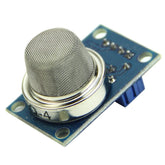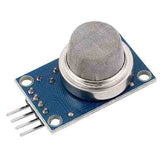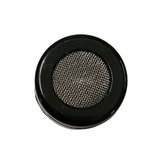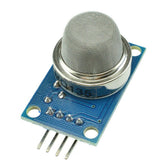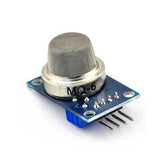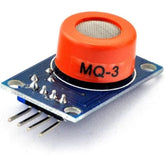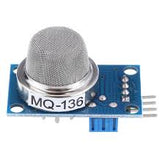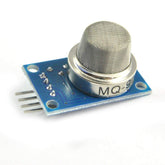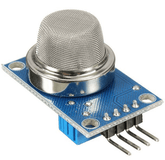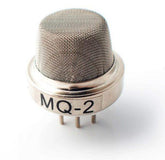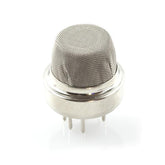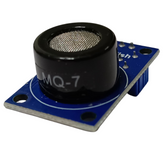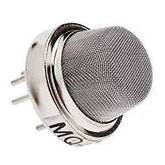MQ Series Gas Sensors – Working, Types & Applications
Summary
Are you seeking for a blog that gives a full description of gas sensors, including the MQ series, and their applications?
If the answer is yes! Then read this blog article, which provides a full review of the MQ series of gas sensors, including the MQ-2, MQ-3, MQ-4, MQ-5, MQ-6, MQ-7, MQ-8, MQ-9, MQ-131, MQ-135, MQ-136, MQ-137, MQ-138, and MQ-214.
1 Parts per million, or 1 ppm, is defined in this blog article along with its application in gas concentration measurements.
The description of each MQ series gas sensor and its uses that follows will be helpful to anybody who wants to understand the foundations of gas sensing technology.
Introduction
The MQ Series Gas Sensor is a revolutionary technology designed for the detection of combustible gases, such as those used in industry and manufacturing.
MQ sensor working principle involves detecting changes in electrical conductivity when specific gases come into contact with the sensor's sensing element.
The MQ sensor full form typically refers to "Methane/CH4 Quality Sensor" in the context of gas sensors. These MQ gas sensors are crucial for gas detection in various applications.
This MQ sensor is capable of detecting even minute amounts of gas without any false alarms or false positives.
The combination of advanced sensing technologies with an innovative design allows users to quickly identify potentially hazardous conditions before they lead to serious problems.
Additionally, it has long-term stability due to its self-compensating properties which protect it against various environmental factors including temperature changes, air pressure fluctuations, and chemical influence from contaminants.
Therefore this MQ sensor provides reliable monitoring while reducing maintenance costs significantly over time and increasing safety both inside working environments or out on-site operations scenarios saving businesses thousands every year by avoiding incidents that could affect lives and property alike.
With a simple installation process coupled with low cost makes it highly attractive option compared other competitors in present market offering similar products making sure all relevant regulations are met efficiently.
Its customer review speaks for itself about excellent performance delivering promising results one can expect providing peace of mind when implemented at work premises ensuring a safe environment workplace.
What is a Gas Sensor?
Determining leakage is crucial in industries, residences, and workplaces since dangerous gases harm the environment.
A typical human nose has 400 scent receptors, allowing humans to detect over 1 trillion different odors. But most of us cannot determine the kind or quantity of gas in our atmosphere.
This is where sensors come to mind, using the specified gas sensors it is easy to determine the leakage of gas.

There are different types of sensors according to the gas, these types of sensors are used to locate and classify various gases.
They are frequently employed to estimate gas concentrations and identify explosive or dangerous gases.
In other words, a series of sensors known as MQ gas sensors (mq sensor) are used to determine a variety of gases, including alcohol, smoke, methane, LPG, hydrogen, NH3, benzene, and propane.
These sensors consist of an electrode that has a sensing substance placed on top and is heated to increase its reactivity and sensitivity. When the type of gas is in the range, these electrodes determine by decreasing the resistance.
Types of Gas sensors
The gas sensors are divided into different MQ series sensors depending on the gas or application. Here is the MQ sensor list of different series.
|
Series of Gas |
Purpose/Type of gasses |
|
MQ - 2 |
Methane, Butane, LPG, smoke |
|
MQ - 3 |
Alcohol, Ethanol, smoke |
|
MQ - 4 |
Methane, CNG Gas |
|
MQ - 5 |
Natural gas, LPG |
|
MQ - 6 |
LPG, butane gas |
|
MQ - 7 |
Carbon Monoxide |
|
MQ - 8 |
Hydrogen Gas |
|
MQ - 9 |
Carbon Monoxide, flammable gasses |
|
MQ - 131 |
Ozone |
|
MQ - 135 |
Air Quality (CO, Ammonia, Benzene, Alcohol, smoke) |
|
MQ - 136 |
Hydrogen Sulfide gas |
|
MQ - 137 |
Ammonia |
|
MQ - 138 |
Benzene, Toluene, Alcohol, Acetone, Propane, Formaldehyde gas, Hydrogen |
|
MQ - 214 |
Methane, Natural gas |
What is 1ppm equal?
When measuring gases such as carbon dioxide, oxygen, or methane, the quantity of gas per volume of air is called concentration.
1 ppm can stand in a variety of ways depending on the chemical being tested. The most common measures for expressing ppm are milligrams per kilogram (mg/kg), microliters per liter (L/L), and micrograms per litre (g/L). A better illustration.
The ratio of one gas to another is given in parts-per-million (ppm).
For example, if methane is measured at 1 parts-per-million, one molecule will be methane, while the other molecules will be another gas present in the atmosphere.
ppm = 1/10,00,000 = 0.0001%
Short description and features of each gas sensor
MQ2 gas sensor
The electronic gadget called the MQ2 gas sensor is capable of detecting a wide range of gases, including hydrogen (H2), propane, liquefied petroleum gas (LPG), methane (CH4), carbon monoxide (CO), alcohol, smoke, and others.
It is commonly used in household and industrial settings to identify gas leaks and avert potential hazards.
One of the most remarkable characteristics of the MQ2 gas sensor is its high sensitivity and quick reaction time, which enable early detection of gas leaks.
This expertise is essential since gas leaks may risk human life and safety, damage equipment, and contaminate the environment.
The MQ2 gas sensor module consists of a sensing device and a circuit board that amplifies and processes the signal.
The sensing element is constructed of a tin dioxide (SnO2) semiconductor that detects the presence of certain gases.
When gas molecules come into touch with the SnO2 surface, the sensor's conductivity changes, and the circuit board's output voltage adjusts appropriately.
To adjust the sensor's sensitivity, this is equipped with a potentiometer, which is a variable resistor that allows the user to adjust the reference voltage of the circuit board.
This makes it possible to optimize the sensor's performance and detect gases at specific concentrations.

Features of MQ2 Gas Sensor
- Suitable for use in both residential and industrial environments
- The sensor is very sensitive, it can detect even small amounts of gases quite well.
- The sensor reacts quickly, which helps in spotting gas leaks and possible dangers early on.
- The sensor includes a potentiometer that lets users adjust its sensitivity by changing the reference voltage on the circuit board.
- The sensor module contains a sensing element crafted from tin dioxide (SnO2) semiconductor that detect specific gases with high sensitivity.
MQ - 3 Sensor Module
The MQ3 Gas Sensor module is excellent for detecting gas leaks (in home and industry). It is capable of detecting CO, CH4, Benzine, Hexane, LPG, and Alcohol.
Measurements may be made as soon as feasible due to their high sensitivity and quick reaction rate. The potentiometer can be used to modify the sensor's sensitivity.
This low-cost semiconductor gas sensor module is very simple to operate and has both analog and digital output. This Gas Sensor module can be used in breathalyzers because it is sensitive to alcohol. Benzine is similarly only weakly sensitive to MQ3 Sensor.

Features of MQ3 sensor
- You can easily add this sensor to circuits because it has a simple SIP header interface.
- The MQ-3 Gas Sensor detects alcohol vapor accurately with semiconductor technology.
- The MQ-3 sensor is flexible and may be simply attached to a variety of microcontrollers.
- With its great sensitivity and rapid reaction, the sensor detects alcohol vapor quickly enough to take action.
MQ - 4 Sensor Module(Methane, CNG Gas)

The MQ-4 Gas Sensor is a quick and dependable natural gas sensor with good sensitivity to propane and butane as well as high sensitivity to natural gas and methane. This low-cost, long-lasting natural gas sensor is frequently used to find gas leaks.
Features of MQ4 Sensor
- The MQ-4 Gas Sensor Module detects CNG, methane, and other gases in the air for gas detection.
- Facilitates easy integration into electronic circuits with standard 4 x 0.1′′ header pins.
- Capable of detecting natural gas concentrations ranging from 200 to 10,000 ppm (parts per million)
- Simply connect to 5V power and set the threshold for gas concentration measurement
- Specifically designed for CNG detection, primarily methane (CH4), ensuring suitability for targeted gas detection.
MQ - 5 Sensor Module(Natural Gas and LPG)
MQ-5 Gas Sensor Detectors are highly sensitive and react quickly. The output of the sensor is an analog resistance.
Simply provide the heating coil with 5V, add a load resistance, and connect the output to an ADC.
Features of MQ5 Gas Sensor
- The MQ-5 sensor module alerts users with a buzzer to detect materials.
- The sensor module reduces false alerts by filtering out noises from alcohol, cooking smells, and cigarette smoke.
- The sensor module's potentiometer adjusts sensitivity according to a variety of applications and conditions.
- The sensor's sensitive substance is tin oxide (SnO2), which has low conductivity in clean air but increases conductivity when a burning gas is detected.
- The MQ-5 sensor module detects methane, propane, and butane with high accuracy.
MQ - 6 Sensor Module (LPG, butane gas)
The MQ-6 Sensor is an easy-to-use liquefied petroleum gas (LPG) sensor that can detect airborne LPG concentrations (which are primarily made of propane and butane). The MQ-6 is capable of detecting gas concentrations between 200 and 10,000 ppm.
This sensor responds quickly and with excellent sensitivity. The output of the sensor is an analogue resistance. Simply provide the heating coil with 5V, add a load resistance, and connect the output to an ADC.

Features Of MQ6 Gas Sensor
- The MQ-6 Gas Sensor operates at a voltage of +5V
- Designed for detecting LPG (liquefied petroleum gas) or butane, ensuring reliable detection of these combustible gases.
- Provides continuous and proportional gas concentration indication with an analog output voltage range of 0V to 5V.
- Has a digital output voltage of 0V or 5V (TTL Logic) for easy integration with digital circuits.
- Stable operation achieved after 20-second preheat for accurate and consistent gas detection.
MQ - 7 Sensor Module (Carbon Monoxide)
This type of series module is used to determine the CO, which is clean air and has a lower conductivity. It uses a cycle of high and low temperatures to make the detection and detects CO when the temperature is low (heated by 1.5V).
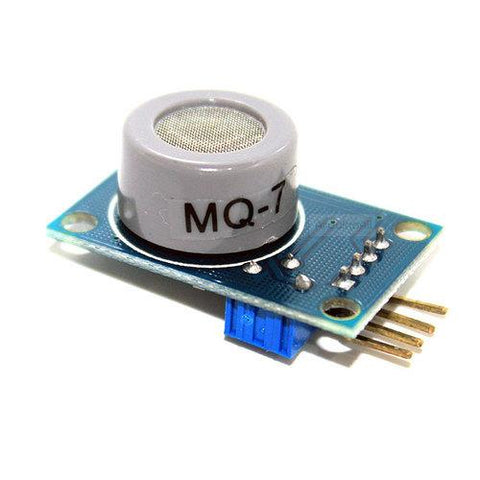
Features of MQ7 Sensor
- Gas leak detectors, safety devices, and industrial control systems all use it to ensure safety and security.
- Designed to detect carbon monoxide (CO) gas and provide accurate monitoring for possible risks.
- Detects CO gas at 20 to 2000 ppm, offering a wide sensitivity range for a variety of applications.
- The chemical reaction with CO gas generates a proportionate current.
MQ - 8 (Hydrogen gas(H2))
This module is appropriate for determining Hydrogen Gas and can detect concentrations ranging from 100 to 10,000ppm.
The heater drive and measuring circuit setup are easy. This sensor has been designed to deliver long-lasting and reliable performance.
Features of mq8 gas sensor
- Designed to detect the presence of hydrogen gas in the air, offering reliable monitoring for potential hazards.
- The chemical reaction between hydrogen gas and a conductive metal oxide produces a current proportional to the amount of hydrogen gas in the air.
- High sensitivity to hydrogen gas allows for accurate detection even at low concentrations.
- Capable of detecting hydrogen gas concentrations between 100 and 10,000 parts per million (ppm).
- Commonly used in gas leak detectors, safety devices, and industrial control systems.
MQ - 9 (Carbon Monoxide, flammable gasses)
This module is suitable for determining CO and flammable gases which in clean air have a lower conductivity. When the temperature is low, it detects CO by cycling between high and low temperatures (heated by 1.5V).
Both the sensor's conductivity and the gas concentration are increasing. It identifies methane, propane, flammable gases, etc. when the temperature rises (heated by 5.0V) and cleans the other gases as it is adsorbed under low temperature.

Features of MQ9 sensor
- Capable of sensing Carbon Monoxide (CO), Methane, and LPG (liquefied petroleum gas).
- For accurate detection, a sensitive tin dioxide (SnO2) substance with low conductivity in pure air is used.
- Gas detection is flexible and adaptable to a variety of applications, including residential, industrial, and transportation.
- Capable of detecting methane, propane, and other dangerous gases, ensuring complete gas detection coverage.
- It employs a temperature cycle to detect CO at low temperatures (1.5V) and methane, propane, and other flammable gases at high temperatures (5.0V).
MQ - 131 (Ozone)
The MQ131 gas sensor is a sensitive component and it has a reduced conductivity in clean air. when there is ozone gas.
Both the sensor's conductivity and the gas concentration are increasing. Please use a basic electrical circuit to convert the change in conductivity to a signal that corresponds to the amount of gas present.

Features of MQ131
- Offers fast response times, ensuring quick detection of ozone gas concentrations.
- Equipped with mounting holes for easy and secure installation in fixed locations.
- The TTL output generates a low signal when valid, with the option to interface with microcontroller IO ports for further processing.
- Includes a signal light to indicate the sensor's output, enhancing user awareness.
- Highly sensitive to ozone gas, detecting concentrations from 10 parts per billion (PPB) to 2 parts per million (PPM).
MQ - 135, Air Quality (CO, Ammonia, Benzene, Alcohol, smoke):
The MQ-135 Gas Sensor can identify dangerous gases and smoke, including ammonia (NH3), sulfur (S), benzene (C6H6), and CO2. This MQ135 sensor, like the others in the MQ series of gas sensors, has a pin for both digital and analog output.
The digital pin turns high when the amount of these gases in the air exceeds a predetermined threshold. The onboard potentiometer can be used to adjust this threshold value.
An analog voltage that is produced by the analogue output pin can be used to approximatively determine the concentration of various gases in the atmosphere.

Features of MQ135 Gas Sensor
- MQ135 utilizes a metal oxide semiconductor gas sensor, which detects gases using a semiconductor material.
- Can detect a wide range of gases, including ammonia (NH3), sulfur dioxide (SO2), and carbon monoxide.
- It uses basic electrical circuits to transform conductivity changes into gas concentration output signals.
- The MQ135 is very sensitive to ammonia, sulfide, benzene vapor, smoke, and other harmful gases, allowing for precision detection in a broad range of applications.
MQ - 136 (Hydrogen Sulfide Gas)
The MQ136 Gas Sensor can be used to keep track of hydrogen sulphide gas concentrations. The sensor's conductivity increases and the concentration of the target hydrogen sulphide gas rise when it is present.
High sensitivity to hydrogen sulphide and low sensitivity to other flammable gases characterize the MQ136 gas sensor. It is inexpensive and appropriate for a variety of uses.
Features of MQ136 gas sensor
- Designed for monitoring hydrogen sulfide (H2S) gas concentration, ensuring reliable detection of potential hazards.
- Uses tin dioxide (SnO2) sensitive material, is less conductive in clean air, and more conductive with hydrogen sulfide gas.
- Provides digital and analog output for easy interfacing with microcontrollers, Arduino, Raspberry Pi, and other devices.
- Utilizes a basic electric circuit to convert conductivity changes into gas concentration output signals.
MQ - 137 (Ammonia)
The conductivity of the sensor increases along with the concentration of NH3 gas when it is present.
A simple circuit can be used by users to translate changes in conductivity into the corresponding output signal of gas concentration.
The MQ137 gas sensor is very sensitive to NH3 gas and has good monitoring capabilities for organic amines like trimethylamine and calamine. It is a type of inexpensive sensor for many purposes that can detect different gases, including ammonia.
It has many advantages including a long lifespan, low cost, a straightforward drive circuit, and strong sensitivity to NH3 gas over a wide range.
Features of mq137 Gas Sensor
- Detects gases including ammonia (NH3) and carbon monoxide (CO), providing diverse gas detection capabilities.
- Designed for ammonia (NH3) gas detection, it is ideal for air quality monitoring, industrial control, and agriculture.
- Detects ammonia gas concentrations ranging from 0 to 1000 parts per million (ppm), providing high sensitivity for a variety of environmental monitoring applications.
- Ammonia is a poisonous gas that, in high quantities, can be dangerous to people, thus use the MQ137 sensor with caution and follow all safety procedures.
MQ - 138 (Benzene, Toluene, Alcohol, Acetone, Propane, Formaldehyde gas, Hydrogen)
The conductivity of the sensor increases as the gas concentration does. Through a straightforward circuit, users can translate the change in conductivity to the corresponding output signal of gas concentration.
Toluene, acetone, alcohol, and methanol are highly sensitive to the MQ138 gas sensor, which also performs well when monitoring hydrogen and other organic vapours.
It is a type of inexpensive sensor for various applications and is capable of detecting different organic gases. It offers benefits including a long lifespan and low cost, and it has good sensitivity to organic vapour gas over a wide range.
Features of MQ138 Sensor
- Detects gases like acetone, alcohol, hydrogen (H2), and toluene, offering versatile gas detection capabilities.
- Versatile for domestic VOC gas alarms, leakage alarms, and portable detectors, ensuring safety across environments.
- Detects VOCs from 5 to 500 ppm, ensuring accurate monitoring.
- The sensor's sensitivity (S) is determined by the ratio of resistance in air (Rs) to resistance in 50 ppm toluene, ensuring reliable detection.
MQ - 214 (Methane and Natural Gas )
Methane (CH4) gas sensor MQ-214 displays its reading as an analogue voltage after detecting the levels of methane in the air.
These gas sensors can identify gases that, are in high concentrations. Detectable concentration: 500–10,000 parts per million for LPG and propane, 1000–20,000 for methane, and 500–10,000 for hydrogen.
Features of MQ214 Gas Sensor
- Capable of detecting a wide range of gases or vapors, providing versatile gas detection capabilities for various applications.
- Requires a simple drive circuit for operation, facilitating easy integration into electronic systems and minimizing complexity in setup and installation.
- Provides stable performance and long lifespan, ensuring reliable and consistent operation over extended periods of use.
- Offers fast response times and high sensitivity, ensuring quick and accurate detection of gases or vapors in the surrounding environment.
Conclusion
In this blog post, we found that MQ sensors are the genuine thing when it comes to recognizing gasses in a variety of situations.
Given its ability to detect even trace amounts of gas, they are a dependable and cost-effective safety option.
MQ sensors can be used to detect potentially dangerous items, make sure your industrial equipment is in excellent working condition, or keep an eye on the quality of the air you breathe.
Why then are you acting hesitantly? Don't miss the opportunity to utilize the remarkable features that the MQ Series gas sensors have to offer. They stand for the most effective ways to protect the environment and guarantee a secure and healthy future.
If you appreciate our work don't forget to share this post and leave your opinion in the comment box.
Please do check out other blog posts about Popular electronics
Make sure you check out our wide range of products and collections (we offer some exciting deals!)



